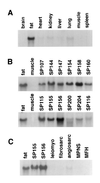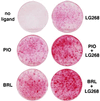Terminal differentiation of human liposarcoma cells induced by ligands for peroxisome proliferator-activated receptor gamma and the retinoid X receptor
- PMID: 8990192
- PMCID: PMC19300
- DOI: 10.1073/pnas.94.1.237
Terminal differentiation of human liposarcoma cells induced by ligands for peroxisome proliferator-activated receptor gamma and the retinoid X receptor
Abstract
Induction of terminal differentiation represents a promising therapeutic approach to certain human malignancies. The peroxisome proliferator-activated receptor gamma (PPAR gamma) and the retinoid X receptor alpha (RXR alpha) form a heterodimeric complex that functions as a central regulator of adipocyte differentiation. Natural and synthetic ligands for both receptors have been identified. We demonstrate here that PPAR gamma is expressed at high levels in each of the major histologic types of human liposarcoma. Moreover, primary human liposarcoma cells can be induced to undergo terminal differentiation by treatment with the PPAR gamma ligand pioglitazone, suggesting that the differentiation block in these cells can be overcome by maximal activation of the PPAR pathway. We further demonstrate that RXR-specific ligands are also potent adipogenic agents in cells expressing the PPAR gamma/RXR alpha heterodimer, and that simultaneous treatment of liposarcoma cells with both PPAR gamma- and RXR-specific ligands results in an additive stimulation of differentiation. Liposarcoma cell differentiation is characterized by accumulation of intracellular lipid, induction of adipocyte-specific genes, and withdrawal from the cell cycle. These results suggest that PPAR gamma ligands such as thiazolidinediones and RXR-specific retinoids may be useful therapeutic agents for the treatment of liposarcoma.
Figures




References
-
- Mack T M. Cancer. 1995;75:211–244. - PubMed
-
- Chang H R, Hajdu S I, Collin C, Brennan M P. Cancer. 1989;64:1514–1520. - PubMed
-
- Patel S R, Burgess M A, Plager C, Papadopoulos N E, Linke K A, Benjamin R S. Cancer. 1994;74:1265–1269. - PubMed
-
- Warrell R P, Jr, Frankel S R, Miller W H, Jr, Scheinberg D A, Itri L M, Hittleman W N, Vyas R, Andreef M, Tafuri A, Jakubowski A, Gabrilove J, Gordon M S, Dmitrovsky E. N Engl J Med. 1991;324:1385–1393. - PubMed
Publication types
MeSH terms
Substances
Grants and funding
LinkOut - more resources
Full Text Sources
Other Literature Sources

